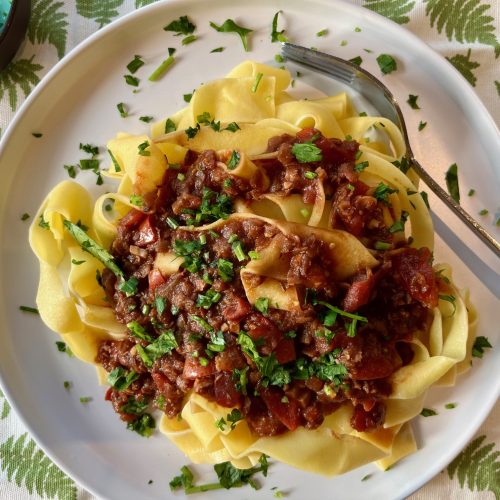 A couple of weeks ago, I attended the CHFA NOW show (Canadian Health Food Association Natural Organic Wellness). It’s Canada’s biggest trade show and conference dedicated to natural health, organic and wellness products.
A couple of weeks ago, I attended the CHFA NOW show (Canadian Health Food Association Natural Organic Wellness). It’s Canada’s biggest trade show and conference dedicated to natural health, organic and wellness products.
Here are the top 10 products that caught my eye! (Note: these are product highlights only and not intended as product endorsements.)

1. No / Low-Alcohol Beverages
I had the opportunity to taste test an alcohol-free Riesling. The verdict? Loved it! According to recent info from Statistics Canada, millennials and Gen Zers are most likely to refrain from drinking alcohol, and it’s these demographics who are really driving the no / low alcohol trend. No alcohol beer was also featured at the show.

2. Bone Broth Hot Chocolate
The bone broth trend has been kicking around for a while now. The nutritional value of bone broth varies depending on the ingredients and how it’s made. This bone broth hot chocolate comes in a sachet and is made by adding a cup of hot water or hot milk. Each serving contains 14 grams of protein. I had a sip and quite enjoyed it. The product lineup also includes bone broth matcha and bone broth coffee.

3. Bedtime drink
No one can argue the importance of a good night’s sleep for health and wellness. A new beverage called “Straight Zzz” is a lightly carbonated drink made with subtle lavender and chamomile notes. Each 355 mL serving contains 100 mg of magnesium (which is within your daily requirement) and 23 mg of L-theanine (a type of amino acid). Both magnesium and L-theanine can help with relaxation. This contains about the same amount of L-theanine found in a cup of green tea. (This product was #gifted to me and I haven’t yet tried it.)

4. Protein Puffs
The first three ingredients in these snacks are egg whites, lentil protein and lentil flour! There’s also pea flour. The puffs are baked, not fried, and gluten-free. They have the texture of a “cheesie” snack. A serving (about 1 cup) of the Sour Cream and Onion flavoured puffs contains 12 grams protein, 3 grams fat, 0 grams saturated fat, 2 grams fibre and about 14% DV (Daily Value) for sodium. A sample was #gifted to me. I gave them a try and quite enjoyed them.

5. Cinnamon Churro Puffs
Another innovative snack, these puffs are made from all plant-based ingredients like cassava starch, butternut squash, rice and sorghum. Paprika is used for colouring. There’s only 1 gram fibre per serving, 2 g protein and 7 g fat, but the sodium is low at 8% DV (Daily Value.) Overall, the puffs weren’t bad. They were very crispy and I would have liked a bit more cinnamon flavour.

6. Protein Ramen
Although I don’t often eat these noodles in a cup, I was intrigued by the protein content. Each cup contains 20 grams protein, derived from pea protein. As with many soups, the sodium is quite high at 49% DV (Daily Value) and there’s also quite a bit of fat – 14 grams.

7. Chocolate with Protein
Now that you’ve read about pea protein being added to snacks and ramen, guess what? Yes, you guessed it – pea protein in chocolate. I tasted a 44% dark chocolate bar with pea protein. There’s 5 g protein in a 25 g chocolate bar. It wasn’t too sweet and I did notice a somewhat beany aftertaste. It may be an innovative option for those looking for a “healthy indulgence.”
 8. Dried Fruit Chips
8. Dried Fruit Chips
With a factory out west in Squamish, British Columbia, these dried fruit snacks are made from up-cycled fruit. I love the concept of reducing food waste and this product checks the box. The drizzle of chocolate adds a little decadence to the dried oranges. Other flavours include dried kiwis, dried pineapples and dried mangos.

9. Sustainably made Sodas and Ciders
The Lasser family grows apples and fruit in the Similkameen Valley of British Columbia. Millions of pounds of fruit from their orchards are deemed “ugly”and not pretty enough to be sold in stores. From farm to bottle, these fruit are upcycled into sodas and ciders. The product brand “Lass Chance” is a nod to the family name. Great tasting, and the product names are just too cute: Apple-y Ever After, Life’s A Peach, Picture Pear-fect, and Dreams do Plum True!

10. Flax Milk
What makes this beverage stand apart from other plant-based beverages is the fact that it contains phyto-estrogens and omega-3 fat. Each serving contains 15 grams of flax which translates to 3 grams of ALA (the plant-based omega-fat.)It’s fortified with calcium, vitamin A and vitamin D, essentially on par with what you’d find in a cup of cow’s milk. The protein in flax milk is a bit lower (4 grams) and the fat is a little higher due to the omega-3 content. I tried both the unsweetened and vanilla flavours and thought it tasted refreshing.
To see more product innovations from the CHFA NOW show, check out my short Instagram videos: Part 1 video, Part 2 video.

 A couple of weeks ago, I attended the CHFA NOW show (Canadian Health Food Association Natural Organic Wellness). It’s Canada’s biggest trade show and conference dedicated to natural health, organic and wellness products.
A couple of weeks ago, I attended the CHFA NOW show (Canadian Health Food Association Natural Organic Wellness). It’s Canada’s biggest trade show and conference dedicated to natural health, organic and wellness products.






 8. Dried Fruit Chips
8. Dried Fruit Chips 

